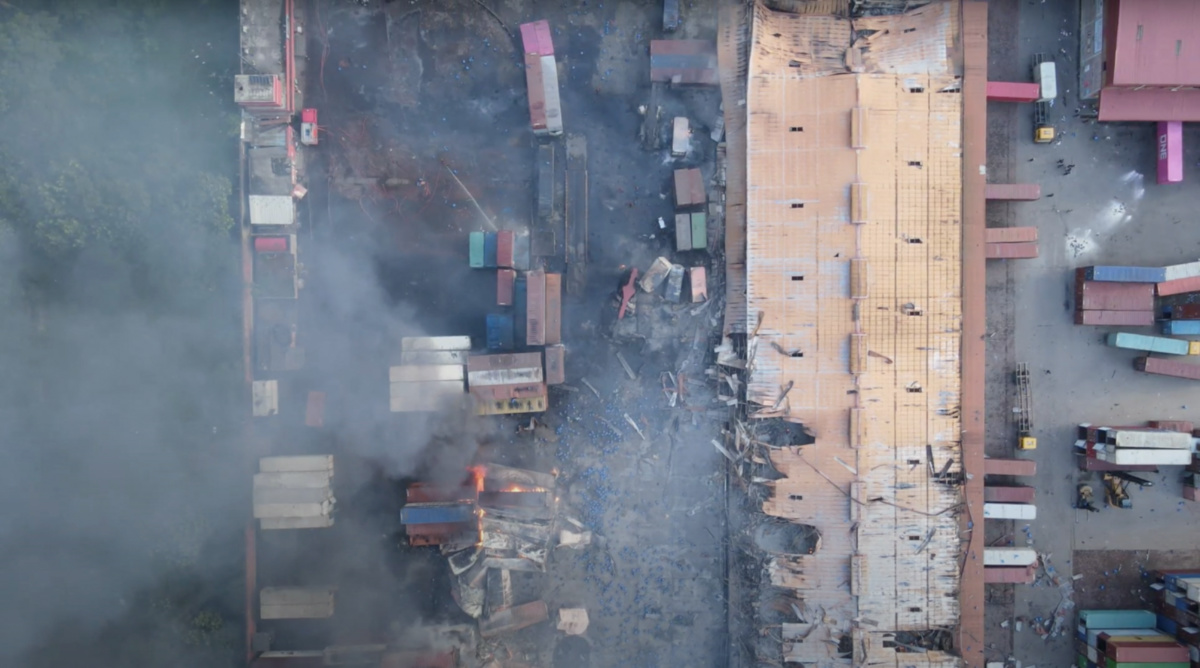Dhaka, Bangladesh
Reuters
A deadly fire at a container depot in Bangladesh has laid bare the dangers still facing millions of the country’s workers a decade after a series of tragedies in the export-focussed garment industry spurred a safety revolution.
Intense scrutiny of Bangladesh and the major international clothing retailers that rely on it for supplies has helped prevent further disasters in the garment sector since a fire in 2012 and a building collapse in 2013 together killed more than 1,200 workers.

Drone footage shows smoke rising from the spot after a massive fire broke out in an inland container depot at Sitakunda, near the port city Chittagong, Bangladesh, on 5th June in this still image obtained from a handout video. PICTURE: Al Mahmud BS/Handout via Reuters.
But in other industries, mainly catering to Bangladesh’s booming domestic economy and without an equal emphasis on safety, hundreds have died in fires in recent years.
At least 41 people burned to death in a depot blaze that erupted on Saturday and has yet to be extinguished. Nearby containers loaded with chemicals pose a risk of further life-threatening explosions.
Bangladesh saw its last major garments factory fire in early 2017 in which six workers were killed. But fires in other commercial settings or factories, making everything from fans to fruit juices, have killed at least 200 since then and injured many more, according to a Reuters count.
“The safety is more in the garments sector than in other industries because there is an international compliance-monitoring system, and no compliance means no orders,” said Jewel Das, general secretary of the Bangladesh Association of Fire Consultants that works with the government on fire audits.
“But in other sectors, there is no international monitoring system and the national monitoring system is not strong.”
Unlike established garment businesses which have their power systems including diesel generators located away from their factories, many other units are built right on top of their power sources.
“Because most fires start from the electrical systems, it’s like sitting above a bomb,” Das said.
He said many non-garment factories also lack fire-safety measures like the segregation of flammable materials, maintenance of fire-escape routes and clear demarcation of assembly areas in the densely populated country of more than 160 million.
Monir Hossain, a senior official at Bangladesh Fire Service and Civil Defence who was inspecting chemicals and fire standards at the depot, agreed that oversight was weak in most other industries. He feared not much would change even after the latest disaster.
“A lot has been done to improve the safety conditions in garments but other sectors still remain out of scrutiny,” said Hossain.
“When something happens, there are investigations but after some time, we all forget that. Then another incident happens.”
At the container depot, he said even basic fire-safety measures were missing. There were only a handful of fire extinguishers, he said, at a site storing everything from clothes to chemicals.
“No compulsion, no compliance”
The world woke up to Bangladesh’s hazardous factory conditions in 2012 when a fire at Tazreen Fashions, which made goods for Walmart Inc and Sears Holdings, killed 112 workers.
The disaster was followed by the collapse of the eight-story Rana Plaza a year later, killing 1,135 garment workers and triggering a wave of public outrage around the world about the human cost of cheap clothes.
This prompted global retailers, foreign governments and international agencies like the World Bank’s International Finance Corporation to act to help the world’s second-largest garments industry improve safety and labour conditions.
The IFC said it had established a five-year, $40 million credit facility for local banks to help garments and related factories upgrade their structural, electrical, and fire safety standards.
We rely on our readers to fund Sight's work - become a financial supporter today!
For more information, head to our Subscriber's page.
No similar arrangements are in place for other industries which have mushroomed as the economy has grown much faster than in many other countries in the past decade.
The International Labour Organization said it was working with Bangladesh’s fire, factories and other departments to improve safety across the economy.
“The lessons learned from the garment sector should be channelled towards focused interventions in other sectors based on hazards and risk to health and safety,” it said.
“An effective national industrial and enterprise safety framework as well as enforcement and training system is needed in Bangladesh.”
Ali Ahmed Khan, who was the chief of the fire department until a few years ago, said Bangladesh now needs to focus on the small and medium-sized industries if it wants to stop a recurrence of deadly fires.
He said industries like leather goods, pharmaceuticals and plastic goods were stepping up exports but were not fully compliant with fire-safety rules.
“Unless there is a compulsion, people will not comply,” he said.





